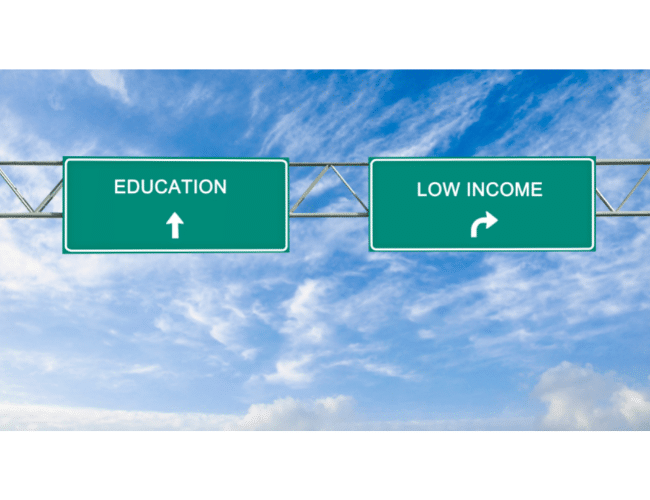Can You Go To College Without Student Loans?

Student loans create long-term debt that last over half a lifetime for many students. So its extremely important that students find a way to attend college without student loans.
To go to college without student loans, students need to:
-
Attend a tuition-free college
-
Attend a college with a no-student-loans financial aid package
-
Attend a transfer-friendly college with reduced tuition and minimized living expenses
-
Have the employer pay for remaining tuition that is not covered by scholarships or grants
Not all colleges promote a no-student-loans policy. So it is extremely important that you choose a college that has such a policy, or a college that literally makes student loans unnecessary due to affordable tuition or a better financial aid package.
How To Go To College Without Student Loans
The first step toward college without student loans is to make a commitment to yourself that you will NOT take student loans at any cost.
Student loans are a huge burden on college graduates; many college graduates delay marriage and delay buying a home or even a car because of their over-hanging student loans. You certainly do not want to start your career and life with this burden of student loans.

Tuition-Free Colleges
Work-study colleges such as Berea college or College of the Ozarks provide free tuition in return for a fixed number of work hours either on-campus or in the local community.
University of the People (UoPeople) is a nationally-accredited tuition-free college that charges a small fee for the online proctored exams. There are primarily 4 types of degrees offered at UoPeople namely in the areas of Business Administration, Computer Science, Health Sciences and Education.
No Student Loan Colleges
Several colleges in the U.S. such as Cornell University and Vassar College provide financial aid to students without the need to take any student loans. There is a family income threshold needed to qualify for such a financial package.
Even some ivy league colleges such as Harvard and Princeton provide such financial aid packages. So its always best to check with the colleges about a no-student-loans-package before starting college.
Transfer-Friendly with Minimum-Tuition Colleges
Degree completion colleges are the most transfer-friendly and many of them allow an unlimited number of previous college credits to be transferred to their degree program. Some of them have reduced tuition, but the key area they shine in is that they allow many external credits from CLEP and other ACE and NCCRS accredited courses.
The acceptance of all these low cost, external credit courses makes the tuition to be almost negligible compared to most college tuition per credit hour.
For a low monthly fee of less than $100, students can take an unlimited number of credit courses from online providers such as Study.com or StraighterLine. CLEP and DSST courses cost less than $90 each and there are many inexpensive ways to study for CLEP for a low monthly fee such as at InstantCert.
Employer-sponsored College Tuition
Many employers such as Google, Amazon, Walmart and Microsoft contribute to their employee’s college expenses. Most companies reimburse the employee’s college expenses for each course after s/he has completed individual courses with an acceptable score or grade.

Many employers pay about $5250 per year as tuition reimbursement for employees who wish to study for college, as they can deduct this as a qualified expense on their taxes.
Here are some companies that provide generous college financial aid to their employees:
- Disney : 100% tuition aid at Disney network schools
- Chipotle: 100% aid for select degrees and high school diplomas
- Starbucks: full tuition support through Arizona State University Online
- Genentech: $10,000 tuition support per year
- Ford Motors: $6,000 per year in tuition reimbursement
Consequences of Student Loans
Many people fall into the trap of student loans thinking they can easily handle it. The fact that there are government loans with lower interest rates lures many students to taking student loans to pay for college. Government loans are also known to provide payment programs that make repaying the loans more manageable.
Though the interest rates on government loans are lower than private loans, they still carry an interest which can quickly start piling up if not paid regularly over the years. Private loans are the worst and carry heavy interest rates and quickly ruin the student or parent’s credit history if any of the payment deadlines are missed for some reason.

The current outstanding student debt in the U.S. as of 2020 is $1.7 trillion. The average person has about $28,000 in student loan debt. This can be a serious roadblock that lowers the quality of life of millions of people in the workforce.
Student loans in normal circumstances can never be discharged even in a bankruptcy and wages too can be garnished if the student loan payments are not paid. Many people have been delaying buying a home, or car, or seriously reconsidered getting married due to the overhanging burden of student loans that seriously impact their financial future.
So its always best to avoid student loans at all cost! Instead secure as much student scholarship as possible and choose a college with affordable tuition so things are little bit easier on you and your family.
How do I pay for college if I have no money?
Here are different ways to pay for college if you have no money:
-
Get a full scholarship for college
-
Attend a free college such as University of the People
-
Attend a work-study college which will also cover living expenses
-
Get a job and have the employer pay for college expenses
-
Get a parttime job and have your parents help with some of your college expenses
-
Choose a college with affordable tuition and pay for it with a parttime job
As you can see now, there are many ways to complete college comfortably even if you do not presently have the money for college. There is NO NEED to take any student loans when there are so many better options for financing your college degree.
No Loan Colleges
Due to the massive accrued U.S. student loan debt running in trillions of dollars, many colleges have created financial aid packages that students can use to fund college without any student loans. These colleges are able to apply for federal scholarships and then fund any remaining tuition via other scholarships or grants that do not have to be paid back.
Many of these colleges such as Dartmouth College and Cornell University have an income limit of $100,000 and $60,000 respectively for the family income for which for free tuition and no parental contribution required.
Not all colleges have an income limit requirement but some of them do. So its best for you to check with the college’s financial aid office on this before choosing the right college for you.
Do all colleges have no student loans policy?
Not all colleges have such financial aid packages but hundreds of colleges since 2018-19 have been implementing such programs. This includes many major universities such as the University of Chicago, University of California at Berkeley, University of Arizona, Stanford University and many more.
Best Financial Aid for Out-of-state Students
Many state universities such as the University of California in San Diego and Santa Barbara, University of New Hampshire, Mississippi State University and Louisiana State University offered complete financial aid to cover the entire out-of-state tuition for select students of about $30,000 per year.
These are generally merit students who have been able to stand out with exceptional academic history or some other areas in which they have been able to stand out from the rest of the students. So anything you can do to get better grades, test scores and so on will go a long way in financing your college education.
Best Financial Aid for Low-Income Families
The Federal Pell Grants program provides the greatest number of financial aid or grants to low-income students. Currently the maximum offered by this grant is $5000 per year.

Additionally, students majoring in teaching who are planning to teach in specific schools after graduation are eligible for about $4000 per year. Those who receive this grant have to commit to teaching in public schools for 4 years. There are also several grants that cover tuition and all other college expenses for military students and veterans.
Many states all across the U.S. also provide tuition assistance to college students. Many of these cover remaining costs that are not covered by a federal scholarship or grant.
There are also several scholarships for low-income students from foundations and corporations such as Microsoft and Google for the benefit of low-income or minority students who have a good academic record.
The Jack Kent Cooke foundation awards millions of dollars in scholarships each year to minority and under-represented students with exceptional abilities in academics, arts or in any other skill areas. As much as about $40,000 per year per cooker scholar student is awarded in college scholarships.
High achieving community college students are given as much as $55,000 per year for the next 2 to 3 years for completing their bachelors degree in any field of their own choosing. Additional assistance and guidance is also provided to the transfer Cooke scholars for choosing the right college and financial aid.
Best Financial Aid for Middle Class
Most need-based financial aid is given to low-income families. Middle-income families generally do not receive as much financial aid unless the student has an exceptional academic record. The only exception to this is some of the top U.S. colleges such as Harvard, Yale, Princeton, Stanford and MIT which offer liberal financial aid to upper and middle income students without the need to take any student loans.
At Harvard, 20% of their students pay nothing for their college and Harvard students graduate debt-free. For students with family income between $120,000 to $180,000, only 10% of the income is used to fund the college expenses. For a student to gain admission to a college such as Harvard or Yale, a very strong academic record is anyway a prerequisite.
However, except for the country’s top colleges, many of the mid-tier colleges do not provide much financial aid to middle-income students with above average but not exceptional academic scores and grades. Most of the Pell Grants, federal and state scholarships cater to the low-income families with family income of about $50,000 or lesser.
So its always in the best interests of middle and upper income students to maintain a strong academic record in their school years and to have near perfect test scores. This will be useful both for admission to the top-tier colleges and also for getting a full merit-based scholarship at most U.S. colleges.
100% Financial Aid to International Students
International students do not get any federal or state aid in the U.S. but a small number of colleges offer full college scholarships to international students. These include colleges such as MIT, Duke, Harvard, Yale, Princeton, Columbia university, among a few others.
It all depends on whether the student is able to get their admission into the college. Once accepted, these colleges usually do all they can to offer a complete financial package to international students.
Most of these small number of scholarships for international students are reserved for the masters and above degrees and its extremely difficult to get a scholarship for the undergraduate degree.
Pay For College Without Financial Aid, Loans or Parents
If you do not quality for financial aid, are unable to get parental help for college, and still do not want to end up taking student loans, there is a still way to go about this.
Simply get yourself a job and then start taking some accredited college courses at Saylor.org, Study.com or Sophia.org. They are all online course providers and each course is eligible for accredited college credits.
Saylor Academy courses are free to take online except for a small fee for the proctored test, the other two have a small monthly fee for unlimited courses. In case you do not have a computer with internet, simply go to a local public library, get a library card and use one of the library computers.
Once you’ve gathered about 20 credits in general areas of study, apply to a degree completion college for your associate or bachelors degree. This is a much better option than attending a community college since you can complete most of your courses quickly online and still have a day job to meet your living expenses.
Once you’ve completed your associate degree, get yourself a better job in the same field as your college major. Then transfer in the credits at the same or another degree completion college for your bachelors degree and complete your degree comfortably without any financial aid, parents or student loans.
